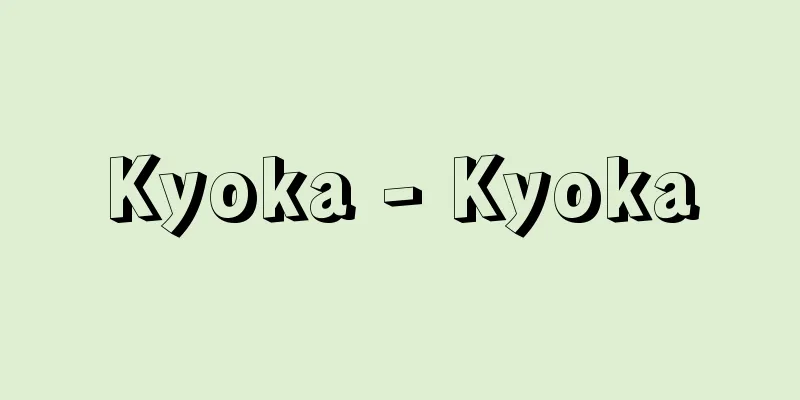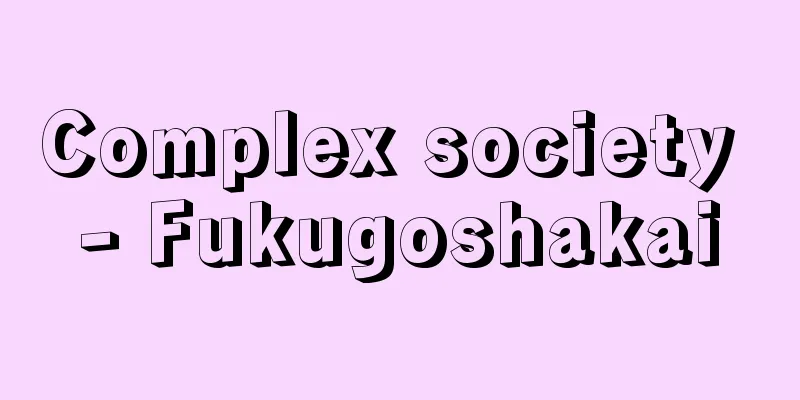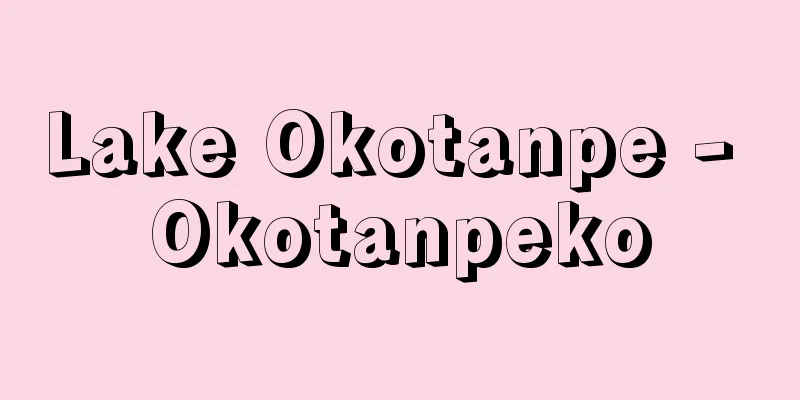Kyoka - Kyoka

|
A literary pastime that flourished during the Edo period. It incorporates familiar, witty, and humorous elements into the classical waka form. There are two types of poems: (1) those that parody existing waka poems, folk songs, and idioms that people are familiar with ("The hototogisu nakitsururu akierataru Gotokudaiji no aki no kao" by Yomono Akara, a poet from Shozan), (2) those that are composed only of techniques such as related words and puns ("It is hard to live in this world, even though the folding screen is bent" by Karakoromo Kisshu), and (3) those that are purely mentally crazy ("The hototogisu nakitsururu kiku sato ni akierataru Gotokudaiji no aki no kao" by Tsumuri no Hikari). In any case, the underlying idea is to evade the traditional authority of waka poetry and enjoy wordplay, not to simply compose waka poems with humorous content. During the Kamakura and Muromachi periods, it was widely performed as entertainment, but because of the strong sense of sacredness in the art of poetry, recording was not permitted, and the unwritten rule was that it should be "spoken" on the spot. A few works remain, such as "Kyowa Sake Hyakushu" from the Kamakura period and "Eisho Kyowa Contest" from the Muromachi period, but these have been preserved by chance, so to speak, illegally. When the Edo period began, kyoka was recognized as a new literary art alongside haiku. It was a reflection of the atmosphere of the times, which enjoyed laughter, and the arrival of peace. In particular, Hosokawa Yusai, a Sengoku warlord and an authority on the art of waka, was known for his quick and witty kyoka, which attracted the attention of the public. It also became popular among the upper classes in Kyoto, including his disciples, the courtiers and high priests. Then, one of these, Teitoku, made an effort to introduce kyoka to the general public, and many of the so-called Teimon haiku poets wrote kyoka. Among them, Nakarai Bokuyo, Ishida Mitoku, and Toyozobo Shinkai were especially known for their kyoka, which became quite widespread. It was Nagata Teiryu, a disciple of Shinkai, who introduced early kyoka, which had been centered in Kyoto, to the masses of Osaka, creating a huge craze for Naniwa kyoka. He taught that kyoka should aim for a "golden kimono with a rope obi," that is, a combination of classical style and the feelings of the common people, but this was difficult for the masses, who lacked classical education, and the kyoka generally fell into dullness and vulgarity, and became something different from the elegance and wit of early Kyoto kyoka. Naniwa kyoka spread to Nagoya, Hiroshima and other places, but did not spread to Edo because it did not suit the temperament of the townspeople. However, in the mid-18th century, amid a trend toward enjoying humorous literature, light literature such as senryu and rhapsody began, and interest in kyoka arose among the young intellectual class of shogunate officials. Karagoromo Kikushi, who loved waka poetry, and Shikata Akayoshi, who was already famous for his rhapsody, took the lead in holding kyoka gatherings under these mad names, and learned townspeople such as Heiji Tosaku and Moto no Mokuami also participated, forming a kyoka group of fairly high calibre. After that, the number of enthusiasts gradually increased and groups were formed in each area. In 1783 (Tenmei 3), Tachibana published "Kyoka Wakabashu" and Akara published "Manzai Kyokashu", which stimulated the so-called Tenmei Kyoka craze. In particular, Shikata Akara's witty and humorous style, which was not limited to classical waka, was well received and took the generation by storm. It also had a great influence on other literary works, painting, and theater, and brought about the heyday of Edo Kyoka. Tenmei Kyoka, which was centered on samurai, changed to be centered on townspeople with the Kansei Reforms (1787-93), and Shikatsube no Mago abandoned the name of Kyoka and called it Haikai-ka, aiming for a style closer to the refinement of waka. In response, Yadoya no Meshimori (Ishikawa Masamochi), a rival of Shingao, criticized the loss of humor and supported the Tenmei style, and the conflict continued until the Bunsei era (1818-1830), but kyoka was no longer at the forefront of literature. After that, Minamoto no Makaji, a disciple of Shingao, insisted on calling it kyoka, and Jingoro Takumi advocated a return to the Tenmei style, but by that time the distinction between Edo kyoka and Kamigata kyoka had disappeared, and kyoka in general had fallen into vulgarity, which continued until the end of the Edo period. [Yoshiichiro Hamada] "Japanese Classical Literature Series 57: Senryu and Kyoka Anthology" (1958, Iwanami Shoten) edited by Hamada Giichiro et al. "Japanese Classical Literature Collection 46: Yellow Cover, Senryu, and Kyoka Anthology" (1971, Shogakukan) edited by Mizuno Minoru et al . "Kyoka Taikan Publishing Association, ed. Kyoka Taikan, 3 volumes" (1983-85, Meiji Shoin) Source: Shogakukan Encyclopedia Nipponica About Encyclopedia Nipponica Information | Legend |
|
江戸時代に盛んに行われた趣味的文芸。古典和歌の形式のなかに、卑近通俗な機知や滑稽(こっけい)を詠み込む。それには、(1)人のよく知る和歌、歌謡、成語など既成のものを踏まえて、それをもじる型(「ほととぎすなきつるあとにあきれたる後徳大寺の有明の顔」四方赤良(よものあから)=蜀山人)、(2)縁語、掛詞(かけことば)などの技巧だけで構成する型(「世にたつは苦しかりけり腰屏風(びょうぶ)まがりなりには折りかがめども」唐衣橘洲(からころもきっしゅう))、(3)心の狂だけの型(「ほととぎす自由自在にきく里は酒屋へ三里豆腐やへ二里」頭(つむり)の光(ひかり))がある。いずれにせよ、和歌の伝統的権威をはぐらかして言語遊戯を楽しむ姿勢が根本であって、単に滑稽な内容を詠む和歌の意ではない。 鎌倉・室町のころ座興としてかなり行われたが、歌道神聖の意識が強いため、記録は許されず、その場限りの「言い捨て」が不文律となっていた。わずかに鎌倉時代の『狂歌酒百首』、室町時代の『永正狂歌合(えいしょうきょうかあわせ)』などが伝えられるが、それらは偶然いわば不法に残ったものである。 狂歌は江戸時代に入ると、俳諧(はいかい)と並んで新しい文芸として認められた。笑いを喜ぶ時代の空気と平和の到来とがしからしめたのであるが、とくに、戦国武将でありかつ歌道の権威者でもある細川幽斎(ゆうさい)が速吟の頓知(とんち)の狂歌をよくしたことが世人の関心を集め、また門下の宮廷人、高僧など京都の上層階級の間に流行がおこったのである。ついで、その一員であった貞徳(ていとく)がこれを一般人士に紹介することに努めたので、いわゆる貞門俳人の多くは狂歌をもつくり、なかでも半井卜養(なからいぼくよう)、石田未得(みとく)、豊蔵坊信海(しんかい)などはとくに狂歌で聞こえ、かなり広く普及した。 京都を中心とする初期の狂歌を、大坂の大衆に導入して浪花(なにわ)狂歌の大流行をおこしたのは、信海門下の永田貞柳(ていりゅう)である。狂歌は「箔(はく)の小袖(こそで)に縄(なわ)の帯」すなわち古典的様式と庶民感情との合一を目ざせと教えたが、古典の教養の乏しい大衆には困難で、全般的に低調卑俗に陥り、京都の初期狂歌の風流や機知とは異質のものとなった。 浪花狂歌は名古屋、広島その他各地に広がったが、江戸には市民の気質にあわないため波及しなかった。しかし18世紀中ごろ諧謔(かいぎゃく)文学を喜ぶ機運のなかで、川柳や狂詩のような軽文学が始まり、また若い幕臣知識層の間に狂歌への関心がおこった。和歌を好む唐衣橘洲、すでに狂詩で名高い四方赤良が中心となり、このような狂名をつけて狂歌会を開き、平秩東作(へつつとうさく)、元(もと)の木網(もくあみ)など好学の町人も参加して、かなり水準の高い狂歌グループが発足した。その後しだいに同好者が増えて地区別の連中(れんじゅう)もでき、1783年(天明3)に橘洲が『狂歌若葉集』、赤良が『万載(まんざい)狂歌集』とそれぞれ狂歌撰集(せんしゅう)を出版したのが刺激となって、いわゆる天明(てんめい)狂歌の大流行がおこった。とくに四方赤良の古典和歌にとらわれない機知と滑稽味豊かな作風が喜ばれて一代を風靡(ふうび)し、他の文芸や絵画、演劇などにも大きな影響を与えて、江戸狂歌の最盛期を現出した。武士を中核とする天明狂歌は、寛政(かんせい)の改革(1787~93)によって町人中心へと変化し、作風も和歌に近い上品さを意図して、鹿津部真顔(しかつべのまがお)は狂歌の名を捨て俳諧歌と称した。これに対して真顔の競争相手であった宿屋飯盛(やどやのめしもり)(石川雅望(まさもち))は笑いを失ったのを非難して天明調を支持し、対立は文政(ぶんせい)年間(1818~30)まで続いたが、狂歌はすでに第一線の文学ではなかった。その後、真顔門下の源真楫(まかじ)が興歌(きょうか)とよぶことを主張したり、尽語楼内匠(じんごろうたくみ)が天明調復帰を説いたりしたが、すでに江戸狂歌、上方(かみがた)狂歌の区別もなくなり、おしなべて低俗に堕して幕末に至ったのである。 [浜田義一郎] 『浜田義一郎他校注『日本古典文学大系57 川柳狂歌集』(1958・岩波書店)』▽『水野稔他校注『日本古典文学全集46 黄表紙・川柳・狂歌』(1971・小学館)』▽『狂歌大観刊行会編『狂歌大観』全3巻(1983~85・明治書院)』 出典 小学館 日本大百科全書(ニッポニカ)日本大百科全書(ニッポニカ)について 情報 | 凡例 |
>>: Common area fee - Kyoekihi
Recommend
Liquid carburizing method
…When hardened after carburizing, the surface bec...
Cassiopeia A - Cassiopeia A
The first radio source discovered in the constella...
saddle quern
…The materials used were diverse, including veget...
Cobanega (small-winged moth) - Cobanega
A general term for insects in the Micropterigidae ...
Grain-gnawing beetle
...Both adults and larvae of the Trogositidae fam...
Ovis aries (English spelling) Ovisaries
… Even though sheep are not used much as a source...
Osakikamijima
It is an island in the Geiyo Islands in the Seto ...
Experiments in Art and Technology
…A group of artists and engineers formed in New Y...
Homburg
…Among felt hats, those with a hard finish are ca...
Azuma Ohno - Azuma Ohno
A military commander in the early Nara period. So...
Okisen-do
〘Noun〙 In the Edo period, the person in charge of ...
Parquet construction - Yosegizukuri
A wooden Buddha statue or structure that uses mul...
Counterculture
Counterculture is a culture created by people who ...
Thunia
...(1) Tropical Asia: A wide area stretching from...
General appeal - Ippankoukoku
…The term appeal is not only used in civil and cr...









